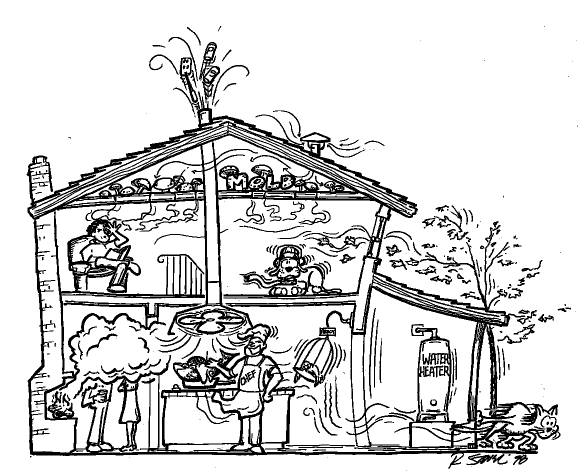
Bruce Manclark is co-owner of Delta-T, an energy services company in Eugene, Oregon. He has spent 20 years in energy conservation.
No longer relegated to the garage or the workshop, the search for more power is taking over the kitchen, as commercial-sized kitchen fans invade the home. The problem is, residential kitchens aren't regulated the way commercial kitchens are. This causes potential hazards when these huge fans are turned on.

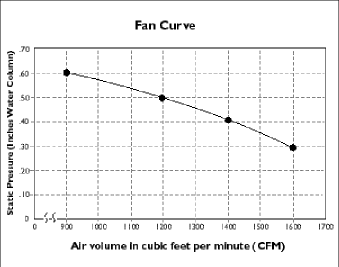
|
| Figure 1. A fan curve illustrates the effect of static pressure on the performance of the fan. As the pressure (imposed by the resistance of the hood, exhaust duct, and tightness of the house) increases, the flow decreases. |
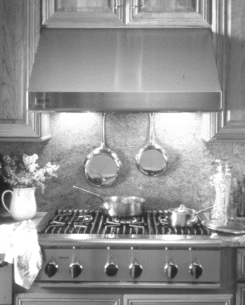 |
| This Thermador Professional Series 36" gas cooktop with hood can hold a fan as large as 1,400 CFM. |
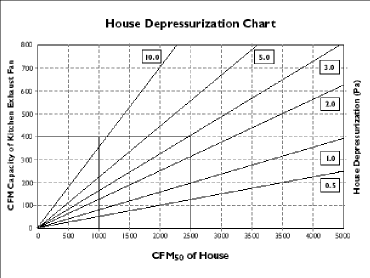 |
| Figure 2. A house will become more depressurized as its tightness increases or as the size of the kitchen fan is increased. |
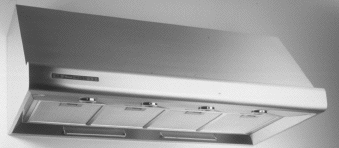 |
| A Thermador 49" Professional Series Wall Hood in stainless steel has the look and feel of a commercial fan, but it isn't subject to the same regulations. |
Since Home Energy last reported on the issue of kitchen fans (see Home, Home on the Range Hood," HE Nov/Dec '97, p. 9), sales of high-end residential equipment have only increased. The range hood and exhaust fan are no longer hidden behind cabinets--now they are the focal point of the kitchen. They are architecturally designed and have hand-finished surfaces; and they are powerful--often with more capacity than an HVAC fan.
Another indication of the growing size of kitchen fans can be found in the Certified Products Directory of the Home Ventilating Insitute (HVI). The 1990 directory listed 33 range hood fans over 250 CFM, with the largest rated at 1,170 CFM. By 1995, this had increased to 39 fans. By 1998, it listed 52 range hoods rated at 250 CFM or more, with the largest rated at 1,200 CFM.
To picture the effect of such a large fan on a home, imagine that the range hood is attached to a giant vacuum cleaner on the outside of the house. The vacuum draws air out of the house, which depressurizes it. As the level of depressurization increases, other appliances that typically exhaust air begin to backdraft, pulling fumes back into the house. For example, smoke in a backdrafting chimney is pulled by depressurization back down the chimney. The fumes in a backdrafting water heater are sucked back down the exhaust flue and into the house. Finally, backdrafting is extremely dangerous. According to the Consumer Products Safety Commission (CPSC), 214 people died in US homes from CO poisoning in 1993 alone.
Cooktops with eight burners plus a grille are showing up in residential settings. There are various rules of thumb for matching the size of the cooktop to the size of the fan. A common one is 300 CFM per linear ft of cooktop. Thus a 48-inch cooktop needs a 1,200 CFM fan. These rules of thumb come from the commercial sector where codes are very specific about the installation of kitchen fans.
This is in sharp contrast to how kitchen fans are installed in a residence. There is no language in the residential codes that ensure the safe installation of large commercial fans. The residential kitchen ventilation requirement in all three Model Codes and ASHRAE Standard 62 is for a 100 CFM fan or range hood. The industry recommendation from the HVI is for a minimum of 40 CFM per linear ft of cooktop. According to this rule, a 48-inch cooktop needs only a 160 CFM fan.
Makeup air is usually tempered (heated or cooled to offset the outside temperature) to ensure the comfort of kitchen staff. Installing makeup air devices also ensures that large amounts of air from the eating area of the restaurant are not drawn into the kitchen. This can create drafts that affect the comfort of the diners.
In many jurisdictions, the owner of a commercial building must pass a performance-based test that certifies that the makeup air is sufficient for the fan and grease filter to work safely. Testing and balancing companies typically administer these tests. They measure the flow of both the exhaust and supply fans and check to make sure the restaurant is not depressurized.
While deconstructing this passage might prove humorous, what it actually means is a moot point, because the only way to ensure that "unsatisfactory operation of installed gas appliances" does not occur is to test for it. The goal is to design buildings and systems that work properly in the first place and do not require significant modification. It is important to remember that combustion air is not the same thing as makeup air. Combustion air is the air used by appliances such as gas water heaters and furnaces, and is related to the Btu of the device--the more Btu's are generated, the more air is needed and the larger the vent needs to be. Although combustion air inlets may in some cases help lessen depressurization, it is not what they were designed to do.
Generally speaking, the tighter the house the more likely it is that depressurization will be a problem (see Figure 2). As an example, a kitchen fan drawing 800 CFM in a house with a blower door reading of 2,000 CFM at 50 Pascals (Pa) would cause the house to become depressurized to about 10 Pa. This is enough to backdraft fireplaces and gas water heaters.
As Figure 2 indicates, even a standard kitchen fan of 400 CFM may be sufficient to cause backdrafting in any home tighter than about 1,000 CFM at 50 Pa. But imagine what happens when the fan is designed to exhaust 2,000 CFM. Unless the house has screen doors for exterior walls, the fireplace will backdraft. According to a study done by the federal Bonneville Power Administration, a fireplace with glass doors or an "airtight" wood stove will backdraft at less than 5 Pa. Some fireplaces with glass doors backdraft at
8 Pa of stack-induced pressure.
Homeowner comfort is another important issue. Imagine a winter holiday party. All the friends and family are milling around. Outside it is cold and snowy; inside there is a roaring fire in the fireplace. The host fires up the range to prepare some hors d'oeuvres, turns on the kitchen fan, and suddenly the house is full of smoke and cold air. Another family Kodak moment is made.
As a mechanical contractor, I have no control over the tightness of a house where I am asked to install a kitchen fan. I cannot rely on the house being built poorly enough to rescue me from any potential problems. I must design a safe system, which is a system that supplies makeup air. The goal is simple: to supply an amount of makeup air equal to the amount of air that is exhausted by the fan.
The goal may be simple, but the actual design and installation may not be so easy. Supplying large amounts of air to a house as inconspicuously as possible is the key to homeowner approval. Opening a big window would probably do the job and is certainly the low-cost approach. However, 2,000 CFM pouring through an open window when it's 30° outside is not a good option for most consumers. There are more practical steps to take in the design of a residential air makeup system (see "Designing a Makeup Air System").
Prescriptive
The wrong path is prescriptive. Prescriptive coding works well for such things as determining the minimum size for a floor joist on 16-inch centers for a 16-ft span. The user looks at a table and has an answer. Because we have enough engineering data about the wood we are using, this approach works for such applications. However, it does not work well for kitchen fans.
Among those on the wrong path is the State of Oregon, which has amended the UMC to require that when a fan with a rating of greater than 350 CFM is installed, there must be a 6-inch duct that allows outside air into the zone. This approach gives a prescriptive answer to a problem created by a prescriptive code. This says that it doesn't matter how leaky the house is, that it doesn't matter how much larger the fan is than 350 cfm, and that simply putting a hole in the house will solve the problem. It also ignores the fact that, depending upon where it is, the hole itself may actually depressurize the building! Assuming that the 6-inch hole works as a pressure relief valve, it will allow only about 50 CFM through when the house is depressurized by a 350 CFM fan (assuming average tightness).
Performance
The right path is performance. This means that a test is used to determine whether a given installed system works as specified. Plumbers must pressurize the plumbing system, and it must hold that pressure for a given amount of time before an inspector signs off on it. Determining the leakiness of a plumbing system using a prescriptive approach would result in leaky piping and high utility bills.
An example of a code that is taking the path of performance is the Canadian General Standards Board 51.71-95. This code sets limits for depressurization caused by any source for a variety of combustion appliances. The limits are 5-20 Pa for various types of combustion appliance, such as fireplaces and condensing furnaces. This code requires testing. Nothing is assumed about the leakiness of the house; nothing is assumed about how much air a fan is exhausting. The worst-case depressurization test tells the inspector whether the system passes or fails. The 1999 Minnesota Energy Code uses a similar performance table with limits of 2-25 Pa for different appliances. It also allows the use of a prescriptive table or performance testing. The code requires a supply fan for kitchen exhaust flows over 250 CFM if direct vent appliances are used, and a supply fan for all kitchen exhaust for other appliances. Flows must be matched within 10%.
If large kitchen fans are installed at all, they must be installed as a part of a kitchen ventilation system that includes makeup air, and these systems must be performance-tested in the field.
Designing a Makeup Air SystemWhile more power is important to some people's psyche, what is probably driving the market is the aesthetic appeal of architecturally designed range hoods. Hoods are often the focal point of the modern open kitchen. According to Seattle architect Mark Frankel of Ecotope, "what the average buyer of these hoods wants is the look and style. What the manufacturers need to do is keep the look and drop the fan size to more appropriate levels." Step 2: Decide where to introduce the makeup air. The logical choice is to bring air into the kitchen somewhere. Supplying it through soffits or under toe kicks beneath the cabinetry is our first choice. But there are a lot of other places to introduce the air, depending on the type of house and the owner's preferences. One option is to use an inline fan and force the air into the return air plenum of the furnace, so there is some potential for tempering and filtration (this would work well with small kitchen fans, but not with large ones). Step 3: Determine how much makeup air is needed. If sufficient makeup air is provided, no depressurization will occur. Obviously, some makeup air will be provided through leakage. However, it is best not to count on that. Size the makeup air to match the fan. Step 4: Decide whether or not to temper. Except in very mild climates, it will probably be necessary to temper the incoming air during cold weather. This is most easily done by using inline duct heaters--also known as resistance heat--that kick in when the incoming air is below a set temperature. We set ours at 50° F. Step 5: Develop a control strategy. The makeup air system must work whenever the kitchen exhaust is running. When the fan is turned on, a motorized damper opens and the supply fan turns on. If the kitchen fan has multiple settings, the makeup air system may also need multiple adjustments. A 300 CFM kitchen fan does not need 900 CFM of intake air. The supply fan moves more air when the kitchen fan is turned to a higher setting. If the temperature of the air is below preset limits (50° of supply air), the inline heater comes on. Step 6: Test the system. Worst-case depressurization testing is critical. It is impossible to know the tightness of the house, and the interactions between teh makeup air system and other mechanical systems, without testing. The worst case depressurization test tells you if the makeup air matches the exhaust air, and if other combustion apppliances will backdraft. |
A little surfing:
Bruce Manclark at Delta T in Eugene, OR recommended Shelter Supply especially the make-up air systems.
John Cotton, Fields, recommended a Fan-In-A-Drum.
Article citing Canadian NBC code which requires compliance with the CSA F326 code and some experiments by Dr. James Reardon.
There are lots of tempered make-up kitchen fan air systems on the Internet:
http://www.premiumair.net/MakeUpAirMenu.htm
http://www.greenheck.com/products/makeup/kitchen_combined.html
http://www.tara-associates.com/makeup.htm
Buckley Rumford Fireplaces
Copyright 1996 - 2002 Jim Buckley
All rights reserved.
webmaster